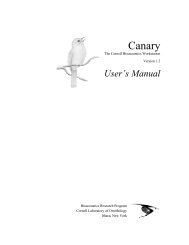A Land Manager's Guide to Improving Habitat for Forest Thrushes
A Land Manager's Guide to Improving Habitat for Forest Thrushes
A Land Manager's Guide to Improving Habitat for Forest Thrushes
Create successful ePaper yourself
Turn your PDF publications into a flip-book with our unique Google optimized e-Paper software.
are most abundant in northern hardwood and transitional<br />
<strong>for</strong>ests with a strong deciduous component at<br />
lower elevations. In Ontario, the range extends north<br />
where deciduous growth occurs in wetlands, after<br />
<strong>for</strong>est fires, or following timber harvest (Cadman et al.<br />
1987).<br />
In the Birds and <strong>Forest</strong>ed <strong>Land</strong>scapes study, Veeries<br />
were detected at 124 (49%) of 253 sites surveyed<br />
in the Northern <strong>Forest</strong> Region. Seventy-four percent of<br />
sites with Veeries were located in mixed <strong>for</strong>est, 17% in<br />
deciduous, and 8% in coniferous <strong>for</strong>est. The most common<br />
trees present on sites occupied by Veeries were<br />
maples (67%), birches (38%), pines (37%), hemlock<br />
(35%), and ash (21%).<br />
Results of this study indicate that Veeries are less<br />
area sensitive than they are further south, with virtually<br />
any size <strong>for</strong>est patch providing suitable habitat<br />
in landscapes that are at least 50% <strong>for</strong>ested. They are<br />
most strongly associated with dense deciduous shrubs<br />
in the <strong>for</strong>est unders<strong>to</strong>ry.<br />
In Maine, where Veery and Wood Thrush overlap,<br />
successional stage was found <strong>to</strong> be the most important<br />
difference in their habitat. Veeries inhabit younger<br />
<strong>for</strong>ests and wetter areas than the Wood Thrush, while<br />
Hermit <strong>Thrushes</strong> and Veeries are sometimes found<br />
<strong>to</strong>gether in mixed coniferous-deciduous and/or mixed<br />
alder and maple <strong>for</strong>ests (Morse 1971). Hagan and<br />
Grove (1999) found Veery <strong>to</strong> be most abundant in partially-cut<br />
<strong>for</strong>est in northern Maine. In Quebec, Veeries<br />
prefer an open canopy and dense unders<strong>to</strong>ry (Gauthier<br />
and Aubry 1996), and they were predicted <strong>to</strong> benefit<br />
from tree removal in mature <strong>for</strong>ests, resulting in greater<br />
shrub cover and unders<strong>to</strong>ry development (Clark et al.<br />
1983). In the White Mountains of New Hampshire,<br />
Welsh and Healy (1993) found Veeries significantly<br />
more abundant in managed rather than unmanaged<br />
stands.<br />
Swainson’s Thrush<br />
The range of the Swainson’s Thrush overlaps the<br />
entire northern <strong>for</strong>est region and extends northward<br />
in<strong>to</strong> the boreal <strong>for</strong>est. In the southern portions, they<br />
occur generally at higher elevations than the Veery or<br />
Wood Thrush and are associated more with coniferous<br />
<strong>for</strong>ests, especially spruce and fir.<br />
In the Birds in <strong>Forest</strong>ed <strong>Land</strong>scapes study, Swainson’s<br />
<strong>Thrushes</strong> were detected at 37 (25%) of 146 sites<br />
surveyed in the Northern <strong>Forest</strong> Region. Seventy-three<br />
percent of sites with Swainson’s <strong>Thrushes</strong> were located<br />
in mixed <strong>for</strong>est, 22% in coniferous <strong>for</strong>est, and 5% in<br />
deciduous <strong>for</strong>est. The most common trees present on<br />
sites occupied by Swainson’s <strong>Thrushes</strong> were birches<br />
(41%), maples (41%), firs (35%), spruces (35%), and<br />
aspens (32%). The small sample in this study did not<br />
indicate an affect of <strong>for</strong>est fragmentation on the Swainson’s<br />
Thrush or allow the calculation of minimum area<br />
of <strong>for</strong>est required <strong>for</strong> high habitat suitability.<br />
This species has been described as a bird of the<br />
extensive spruce-fir <strong>for</strong>ests of Quebec, in areas of relatively<br />
mature <strong>for</strong>est with “not very heavy unders<strong>to</strong>ry”<br />
(Gauthier and Aubry 1996). In Maine, Hagan and<br />
Grove (1999) found Swainson’s Thrush <strong>to</strong> be the only<br />
thrush showing a significant association with mature<br />
<strong>for</strong>est, and <strong>to</strong> be more abundant in landscapes managed<br />
with partial-cut, rather than clearcut techniques.<br />
In a comparison of <strong>for</strong>est management techniques<br />
in Labrador that attempted <strong>to</strong> emulate natural disturbance,<br />
researchers compared bird abundances among<br />
burned and clear cut <strong>for</strong>mer black spruce sites after 5,<br />
14, and 27 years of succession. Hermit <strong>Thrushes</strong> and<br />
Swainson’s <strong>Thrushes</strong> were lower in clear-cut sites and<br />
peaked in the 14-year old burns where abundance<br />
exceeded that of mature <strong>for</strong>ests. Swainson’s Thrush was<br />
positively correlated with deciduous tree cover and<br />
negatively correlated with conifer cover. Logged areas<br />
did support some of the same bird species but did<br />
not mimic fire. This study suggests that <strong>for</strong>est managers<br />
may want <strong>to</strong> allow some <strong>for</strong>ests <strong>to</strong> burn naturally<br />
(Simons et al. 2002).<br />
Hermit Thrush<br />
The Hermit Thrush occupies the entire northern<br />
<strong>for</strong>est region and extends northward through the boreal<br />
<strong>for</strong>est. It is common in both northern-hardwood and<br />
coniferous <strong>for</strong>ests and is more strongly associated with<br />
conifers than the other thrush species. It also occurs on<br />
drier sites, such as jack pine and deciduous <strong>for</strong>ests on<br />
sandy soils.<br />
In the Birds in <strong>Forest</strong>ed <strong>Land</strong>scapes study, Hermit<br />
<strong>Thrushes</strong> were detected at 143 (54%) of 265 sites<br />
surveyed in the Northern <strong>Forest</strong> Region. Eighty percent<br />
of sites with Hermit <strong>Thrushes</strong> were located in mixed<br />
<strong>for</strong>est, 10% in deciduous <strong>for</strong>est, and 10% in coniferous<br />
Table 4. Minimum area required <strong>to</strong> provide high,<br />
moderate, or low habitat suitability <strong>for</strong> Hermit<br />
Thrush based on analysis of 111 study sites in the<br />
Northern region (see page 11 <strong>for</strong> definitions of<br />
habitat suitability).<br />
Percentage<br />
of <strong>for</strong>est in<br />
2,500-acre<br />
block<br />
Minimum area (acres)<br />
required <strong>for</strong><br />
High Moderate Low<br />
90 25 2 Any size<br />
80 71 7 Any size<br />
70 166 16 1<br />
60 359 34 2<br />
50 750 71 4<br />
40 NA a 148 9<br />
30 NA 321 19<br />
20 NA NA 45<br />
10 NA NA 127<br />
a Not Available—acreage values exceed the amount of <strong>for</strong>est in<br />
the 2,500-acre block.<br />
17

















